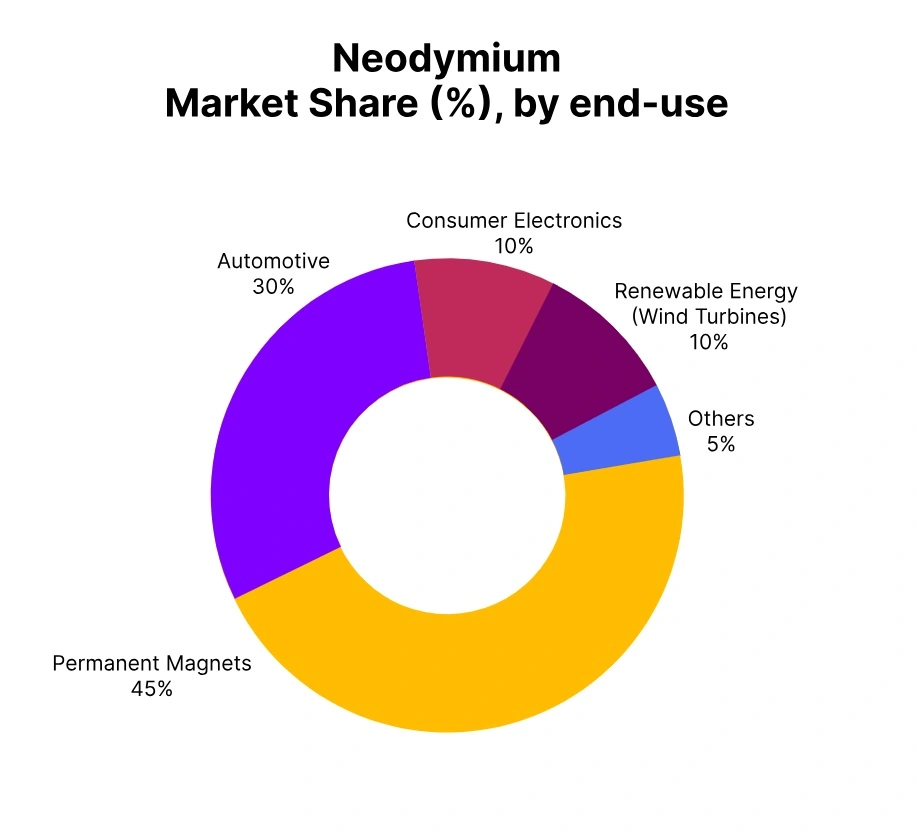Price-Watch’s most active coverage of Neodymium price assessment:
- Purity: 99%min. FOB Sanghai, China
- Purity: 99%min. CIF Houston (China), USA
- Purity: 99%min. CIF Nhava Sheva (China), India
- Purity: 99%min. CIF Rottterdam (China), Netherlands
Neodymium Price Trend Q3 2025
During the third quarter of 2025, neodymium prices experienced an upward trend in the global as a result of strong demand in the electric vehicle, renewable energy and electronics industries amid supply constraints and geopolitical tensions. There has been a significant increase in prices driven largely by cutbacks in shipments from key suppliers like MP Materials to China that caused particularly tight supply.
This price movement reflects neodymium’s importance to high tech industries and should continue, although the chances of the supply being interrupted and geopolitical factors may contribute to price increase in the coming months.
USA
Neodymium Import prices CIF Houston (China), USA, Grade- Purity:99%.
In Q3 2025, the neodymium price trend in the U.S. saw an 8.06% price increase from Q2 2025, driven by strong demand in electric vehicles, renewable energy, and electronics alongside supply constraints influenced by China’s export restrictions.
The Neodymium price trend in the US reflected tightening global supply chains and increased domestic production efforts, with companies like MP Materials benefiting from heightened strategic investments.
The 10.41% increase in neodymium prices in the USA during September 2025 driven by rising demand for rare earth elements in technology and green energy sectors, combined with supply chain constraints.
Additionally, geopolitical tensions and export restrictions from key producers may have further tightened supply, driving prices upward. Looking forward, continued growth is expected as neodymium remains crucial for permanent magnets in clean energy and advanced technologies, making the price trend a key indicator for market dynamics in the coming quarters.
Netherlands
Neodymium Import prices CIF Rotterdam (China), Netherlands, Grade- Purity:99%.
In Q3 2025, the neodymium price trend in Netherlands saw a 7.93% increase in neodymium prices compared to Q2 2025, driven by strong demand from the renewable energy and high-tech sectors, alongside ongoing supply chain constraints and geopolitical challenges.
This price trend showed global market dynamics where neodymium’s growing importance in electric vehicles and wind turbines fuels demand, while limited supply and logistical issues continue to push prices upward.
The 10.38% increase in neodymium prices in the Netherlands in September 2025 likely reflected rising demand for this critical rare earth metal, driven by growth in industries such as electric vehicles and renewable energy.
Additionally, supply chain disruptions or geopolitical factors may have constrained availability, further pushing prices upward. The outlook suggests that neodymium prices in the Netherlands will likely remain elevated heading into Q4 2025, as these factors persist.
China
Neodymium Export prices FOB Shanghai, China, Grade- Purity:99%.
In the third quarter of 2025, the neodymium price trend in China continued to rise, increasing by 3.78% over the second quarter amid strong demand escalating from the electric vehicle (EV) and high-tech sectors as supply has been constrained by applying stricter export policies and higher production costs.
Major producers of rare earth, like China Northern Rare Earth, applied increases to neodymium concentrate prices to reflect market conditions as local government policies have already restricted exports. The neodymium price in China increased 9.34% during September of 2025, due to demand increases that are stemming from expansion in the EV and renewable energy sectors.
Supply chain challenges and geopolitical events have contributed to the tightening supply of rare earths and have contributed further to the increase in prices. The combined challenges of supply scarcity and demand is likely to push up neodymium prices in the near-term.
India
Neodymium Import prices CIF Nhava Sheva (China), India, Grade- Purity:99%.
There has been an increase of 7.41% in India’s neodymium price trend in Q3 2025 as compared to Q2 2025. The increase in the prices has been associated with growing consumption in electric vehicle, renewable energy, and electronics markets.
The neodymium price increases have been further supported by India’s government initiatives to address the ongoing global supply shortages, and geopolitical tensions, especially due to restrictions on exports by China, by way of a new INR 7,300 crore government program to promote domestic capacity for rare earth material and reduce reliance on imports within India as well as a greater supply security.
According to Price-Watch, in September 2025, the neodymium price in India increased by 10.38% driven by strong demand for electronic applications and renewable energy markets, in addition to disruptions in supply chains. Furthermore, due to volatility in the global neodymium market and increased cost of production may have contributed to the price spike.



